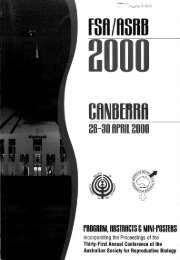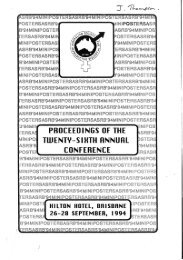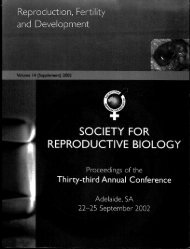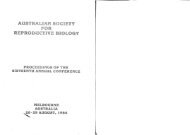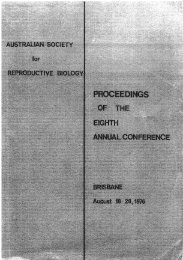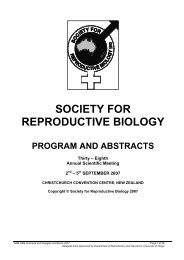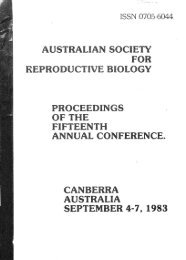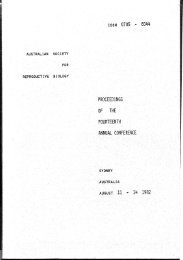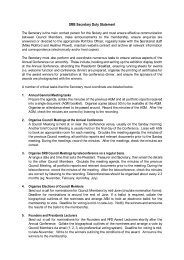N OCIETY' - the Society for Reproductive Biology
N OCIETY' - the Society for Reproductive Biology
N OCIETY' - the Society for Reproductive Biology
Create successful ePaper yourself
Turn your PDF publications into a flip-book with our unique Google optimized e-Paper software.
Effect offeeding management on progesterone release from CIDR devices inovariectomised dairy cowsA.R. Rabieet, K.L. Macmillan! and MJ. Rathbone 2IDepartment of Veterinary Science, University of Melbourne, 250 Princess HWY, Werribee, VIC, Australia2InterAg, 558 Te rapa Road, P.O. Box 20055, Hamilton, New ZealandIntroduction:The effects of nutrition on progesterone production andclearance rates in dairy cattle have not been intensivelystudied. The early postpartum period in cattle ischaracterized by anovulatory anoestrus. The duration ofanoestrus can be affected by body condition andnutritional intake. Progesterone administrated pervagina (CIDR device) has been widely used to treat thiscondition in dairy cattle (1). The efficacy of thistreatment when using a CIDR device partly depends on<strong>the</strong> rate of progesterone released from <strong>the</strong> device (2). Itis not known whe<strong>the</strong>r environmental factors such asnutrition and housing can affect <strong>the</strong> profile ofprogesterone release from a CIDR device. This studywas conducted to determine <strong>the</strong> possible effect of someof <strong>the</strong>se factors on progesterone release from a CrDRdevice in dairy cows.Materials and Methods:Six non-lactating Holstein-Friesian cows wereovariectomised. Plasma and faecal progesteroneconcentrations were measured <strong>for</strong> 4 weeks to monitorcomplete clearance of progesterone from <strong>the</strong> animaltissues following <strong>the</strong> operation. A CIDR device (1.9gprogesterone) was inserted into <strong>the</strong> vagina of each cowat least 4 weeks after ovariectomy and left in place <strong>for</strong>11 days. In <strong>the</strong> first II-day period of study cows werehoused in individual pens and fed with lucerne andoaten chaff (Table 1). In <strong>the</strong> second period, <strong>the</strong>y weregrazed on mixed pasture (2 pastures, Table 1). Theinterval between <strong>the</strong> two periods was 4 weeks. Bloodsamples were taken daily <strong>for</strong> 11 days and progesteroneconcentrations were measured using RIA. A Soxhletextraction technique was used to determine <strong>the</strong> residualamount of progesterone in spent CIDR devicesfollowing insertion in <strong>the</strong> animal (2).Results and Discussion:The only difference in <strong>the</strong> diets fed in <strong>the</strong> two periodswas <strong>the</strong> higher dry matter content of <strong>the</strong> lucerne andoaten chaff in <strong>the</strong> first period (P = 0.001; Table 1).Plasma progesterone concentrations (1.18 ± 0.17 vs1.74 ± 0.34) and <strong>the</strong> amount of progesterone releasedfrom <strong>the</strong> CIDR devices (0.64 ± 0.04 vs 0.88 ± 0.04)were significantly lower during <strong>the</strong> period where cowswere confined and fed with lucerne and oaten chaff (P= 0.02, Fig. 1). These differences may have beenassociated with diet or with housing. Factors whichmay affect <strong>the</strong> amount ofprogesterone that is releasedfrom a device could include <strong>the</strong> rate of blood flow to<strong>the</strong> anterior part of vagina, frequency of defaecation,composition and physical <strong>for</strong>m of <strong>the</strong> diet. Although<strong>the</strong>re was not a significant difference in <strong>the</strong>composition of <strong>the</strong> diet, 'physical <strong>for</strong>m and passage rateoffaeces in confined cows may have altered <strong>the</strong> contactbetween CrDR device and <strong>the</strong> vaginal wall <strong>the</strong>rebyaltering <strong>the</strong> effective surface area <strong>for</strong> release. Bloodmetabolites and protein could also affect vaginalenvironment. However, <strong>the</strong> lack of physical activitywith confinement may also have altered <strong>the</strong> frequencyor pattern of contact of <strong>the</strong> device with <strong>the</strong> vaginalmucosa and consequently reduced <strong>the</strong> amount ofprogesterone released from a device.Table 1: Nutritional values of <strong>the</strong> dietsDM 1 CP 2 Digestibility ME 3Lucerne & 86.4 12.5 64.2 8.9oaten ChaffMixed 41.4 12 61.0 8.5pasture1 Dry Matter 2 Crude Protein 3 Metabolisable Energy2.5GICE 1.5.!!~e 1Il..0.5ChaffPastureFigure 1: Plasma P4 and progesterone released fromCIDR devicesReferences:1) Macmillan KL and Burke CR (1996) Anim. Reprod.Sci. 42: 307-3202) Rathbone MI, et al. (1998) Proceedings of <strong>the</strong>International Symposium on Controlled Release ofBioactive Materials, 25: 249-250.Effect of nutrition on plasma progesterone concentrations in ovariectomiseddairy cows treated with progesteroneA.R. Rabiee and K.L. Macmillan1Department of Veterinary Science, University of Melbourne, 250 Princess HWY, Werribee, VIC, AustraliaIntroduction:Regulatory mechanism controlling luteal function andplasma progesterone (PP4) levels during <strong>the</strong> postpartumperiod have an important role in <strong>the</strong> dairy cattlefertility. The metabolic clearance rate (MCR) ofprogesterone also determines <strong>the</strong> relationship betweenprogesterone production rate and plasma concentration(1). The inverse relationship between feeding level andconcentrations of plasma progesterone (PP4) wasattributed to differences in clearance rate ofprogesterone ra<strong>the</strong>r than to changes in hormoneproduction (2). It is proposed that <strong>the</strong> mechanism <strong>for</strong>controlling PP4 was MCR of progesterone ra<strong>the</strong>r thanproduction rate. In <strong>the</strong> present study, an external sourceof progesterone was administrated and plasmaprogesterone concentrations were measured toinvestigate <strong>the</strong> effect of <strong>the</strong> level of feeding on plasmaprogesterone (PP4) in cows which received twodifferent <strong>for</strong>ms ofprogesterone treatment.Materials and Methods:Six non-lactating Holstein-Friesian cows, which hadbeen previously ovariectomised, were allocatedrandomly into two groups: P4 by subcutaneousinjection (P4-s.c.) and P4 administration per vagina(P4.;p.v.). Cows in <strong>the</strong> P4-s.c. group received a dose of200mg progesterone Iday as in a single injection. Thosein P4-p.v. group, each had a CIDR device containing1.9g progesterone inserted per vagina <strong>for</strong> 11 days. Eachdevice was replaced with a new one after 11 days.Cows were housed in individual pens and fed withlucerne and oaten chaff. In <strong>the</strong> fITst period of <strong>the</strong> study,cows were fed a maintenance ration twice daily in <strong>the</strong>morning and afternoon, and offered on an individualbasis. In <strong>the</strong> second period, <strong>the</strong> entire procedure (partone) was repeated, but cows were fed half of <strong>the</strong> feedrelative to <strong>the</strong>ir requirements. Blood samples werecollected twice daily at 8.00h and 16.00h <strong>for</strong> 11 daysand progesterone concentrations were measured usingRIA.Results and Discussion:The level of feeding had a significant effect on plasmaprogesterone concentrations in <strong>the</strong> P4-s.c., but not in<strong>the</strong> P4-p.v. group (Figure 1). Plasma progesterone wasnot significantly affected by day, time of sampling orany of <strong>the</strong> interactions (P > 0.05). Faecal outputsignificantly declined after reducing <strong>the</strong> maintenance(M) ration to V2 M (Table 1). There was no significantdifference in <strong>the</strong> mass of progesterone released from aCIDR device during <strong>the</strong> M or Yz M periods (0.66 vs0.63 g). O<strong>the</strong>r studies (2,4) have also shown thatprogesterone MCR significantly increased with anincrease in feed intake from Yz M to 2M, or from % Mto M; but not from Yz M to M in intact or CIDR-treatedewes. It has been suggested that <strong>the</strong>re is a directrelationship between <strong>the</strong> level of feed intake and rate ofblood flow to <strong>the</strong> liver and gut, and consequentlyprogesterone clearance rate (3). Studies in cattle (5)also showed that <strong>the</strong> frequency of feeding had asignificant role on peripheral progesteroneconcentrations. Several factors may affect plasmaprogesterone concentration, including <strong>the</strong> difference inprogesterone release rate. The difference in response to<strong>the</strong> level of feeding between two groups may be due to<strong>the</strong> <strong>for</strong>m that progesterone was administrated. The dailydose of progesterone injection and release rate ofprogesterone in <strong>the</strong> P4-s.c. group was greater than in<strong>the</strong> P4-p.v. group. This may have influenced <strong>the</strong> MCRrate of progesterone. These data demonstrate that <strong>the</strong>level of feeding and <strong>the</strong> route of progesteroneadministration have a key role in controlling plasmaprogesterone levels.Table 1: Mean (± SE) of feed intake and faecal outputduring <strong>the</strong> periods of M and Y2 M in both groups ofcows7~6~ 5 m:l1/2 M.sc:eQ) 43*Ql2~a. 10P 4 'pvP4-s.c.P 4 -s cP4-p.v.Feed intake (KgDM) (KgDM)M 11.86 ± 0.43 11.62 ± 1.30V2M 5.91+ 0.24 5.80 ± 0.62Faecal outputM 4.64± 0.09 4.9 ± 0.18Y2M 2.65 + 0.07 2.56 ±0.19Figure 1: plasma progesterone concentrations in P4-s.cand P4-p.v cowsReferences:1) Tait JF (1963) J. Clin. Endocr. 23: 1285.2) Parr RA et al. (1987). J. Reprod. Ferti!. 80: 317320.3) Parr RA (1992) Reprod. Ferti!. Dev. 4: 297-300.4) Williams AH and Cumming IA (1982). J. Agric.Sci. 98: 517-522.5) Vasconcelos JLM et al. (1998) ADSA-ASAS jointmeeting.120 121



